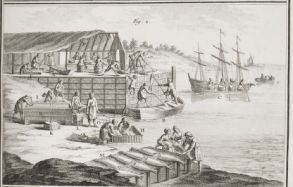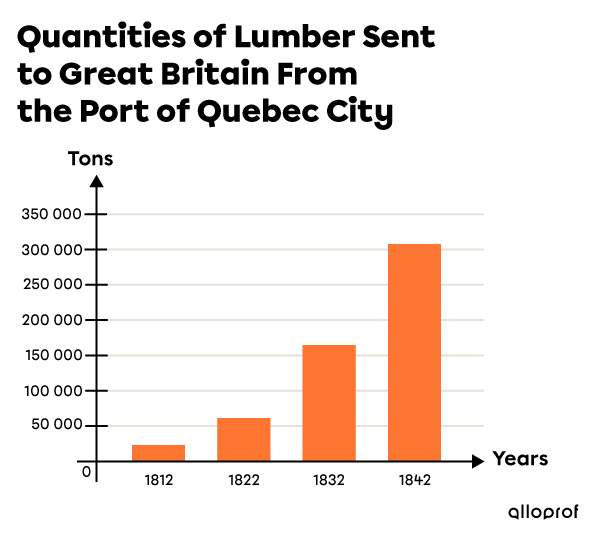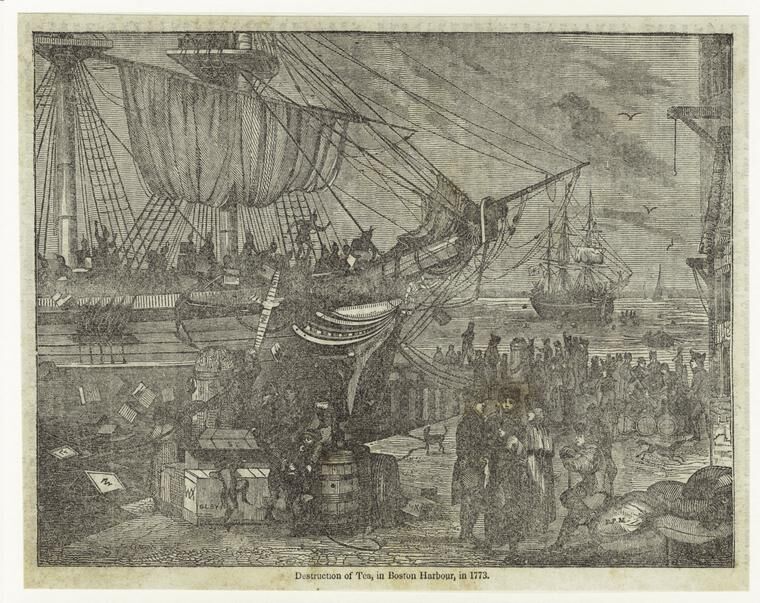A causal connection links two facts. These facts are a cause and a consequence (effect).

Fact 1: Charles goes out in the sun without sunscreen.
Fact 2: Charles gets a sunburn.
What unites the two facts is the causal connection. Charles’ exposure to the sun without sunscreen leads to a sunburn.
Exposure to the sun without sunscreen is the cause of sunburn.
Sunburn is the consequence of exposure without sunscreen.
As part of this intellectual operation, the tasks to be carried out contain 3 items to be connected. In this case, there are 2 causal connections to be established.
You may have heard of this intellectual operation as The Three-Dot Question. It is sometimes unofficially called this because of the 3 statements (3 dots) to be connected.

A fact can be both a cause AND a consequence.
For example, a fact Y can be the consequence of a fact X and the cause of a fact Z.
Concretely, Maikan’s fatigue (Y) may be the consequence of his lack of sleep (X). Maikan’s fatigue (Y) may also be the cause of his headache (Z).
Causal connections can be illustrated using dominoes. The fall of the 3 dominoes represents the 3 facts.

| Fact 1 | I push the first domino, | Cause of fact 2 |
|---|---|---|
| Causal link | which leads to | |
| Fact 2 | the fall of the second domino | Consequence of fact 1 AND cause of fact 3 |
| Causal link | has the effect | |
| Fact 3 | of knocking down the third domino. | Consequence of fact 2 |
Causal connections can be presented in two sentences. For this example, we could write: “I push the first domino, which causes the second domino to fall. The fall of the second domino causes the third domino to fall.”
In this intellectual operation, you will be given three statements, which you will have to match to three documents in order to develop the statements with the help of the documents, and establish the causal connections between each element.
The 3 statements are always placed in order in the question. The only tasks are to develop and connect them.
Using documents 1, 2 and 3, explain how a careless driver’s behaviour can result in a hospital visit.
Answer the question by specifying the items below and connecting them.
- A careless driver
- A cyclist
- A fractured bone
A driver’s careless behaviour on the side of the road can lead to a fall for a cyclist. A cyclist’s fall can cause a fracture.
In the tasks that ask you to establish causal connections, you will have to develop each element and connect the statements. To carry out this intellectual operation, you must associate each statement to a document. It’s up to you to find the document that matches the right statement. The documents will help you develop the statements by guiding you to recall prior knowledge.
Statement: Using documents 1, 2 and 3, explain how the economic activities of Europeans influenced the way of life of certain Indigenous peoples in the territory of North America. Specify the following items and connect them.
- An economic activity practised by Europeans in America
- The place where Europeans established temporary settlements
- The adaptation of an Indigenous community
| Document 1 |
|---|

Cod fishing Europeans erected temporary settlements on the shores of Newfoundland. |
Source: Duhamel du Monceau, H.-L. et La Marre, L. H, 1769-1782. |
| Document 2 |
|---|
|
“At the time of European contact in the early 1500s, the Beothuk occupied at least the south and northeast coasts of Newfoundland. Shortly after the Europeans’ arrival, the Beothuk moved away from their coastal homelands and ancestral fishing camps to inland territories.” |
Source: Tuck, J. A., (2019). Beothuk. In The Canadian Encyclopedia. |
| Document 3 |
|---|
|
“For many Indigenous groups, the fishers’ camps were on lands where they traditionally fished over the summer.” |
Source: Alloprof, n.d. European Fishing in America. |
Here are some clues that can help you correctly match the document with its statement. Document 1 is titled Cod fishing. Document 2 mentions the Beothuk people. Document 3 refers to Indigenous territories occupied by Europeans.
-
An economic activity practised by Europeans in America → Document 1
-
Locations occupied by Europeans while they performed their economic activities → Document 3
-
The adaptation of an Indigenous community → Document 2
This intellectual operation also asks you to develop the statements. You must use your knowledge to develop each of the statements before connecting them.
Here’s a trick that can help you organize information when faced with a similar task.
Write the answer to each statement next to it.
-
An economic activity practised by Europeans in America → Answer
-
The place where Europeans established temporary settlements → Answer
-
The adaptation of an Indigenous people → Answer
Click on the example if you want more details.
Using the documents and your knowledge, you can do the first step of the task: specify the items. The goal is to develop or explain the statements to link them together.
First, you must identify the economic activity practised by Europeans in America.
Next, you must specify where Europeans settled to practise this economic activity.
Finally, you must explain how an Indigenous people adapted to the settlement of Europeans.
An economic activity practised by Europeans in America → An activity practised by Europeans in America is cod fishing.
The place where Europeans established temporary settlements → The Europeans who fished settled on the coasts of Newfoundland, territories occupied by Indigenous peoples.
The adaptation of an Indigenous people → The Beothuk moved their camps inland in Newfoundland due to the presence of Europeans on the coasts.
To make sure you make the two causal connections, write your answer in two sentences so you are less likely to forget one of the two links.
Cod fishing by Europeans in America led to the establishment of temporary European settlements on the coasts of Newfoundland which were occupied by Indigenous peoples. The establishment of these temporary settlements caused the Beothuk to move into the interior of Newfoundland.
It is highly recommended that you read the concept sheet on intellectual operations to fully understand how to complete the tasks for the different intellectual operations.
The two examples below are similar to what you might see on an exam. Try to complete the task before looking at the detailed solution. This will help you to see how well you can do the intellectual operations.
The two examples below are related to concepts that you might not have seen before. If so, don’t worry, you’ll learn them when they are introduced in class.
The first cycle (Secondary 2) example is on the American Revolution module.
The second cycle (Secondary 3) example is on the national demands and struggles module.
Statement: From the documentary record, explain the impact of the Seven Years’ War on the inhabitants of the Thirteen Colonies and how they reacted in 1773.
Answer the question by specifying the items below and linking them.
-
The Seven Years’ War
-
Britain’s actions to bail out its coffers
-
The reaction of the Thirteen Colonies’ inhabitants
|
Document 1 |
|---|
|
“Destruction of Tea, in Boston Harbour, in 1773.” |
Source: The Division of Arts, Prints and Photographs of Miriam and Ira D. Wallach: Picture Collection, New York Public Library, 1839. |
|
Document 2 |
|---|
|
“Furthermore, the British Crown had accumulated debt during the Seven Years’ War. King George III felt that the colonies should help repay the debt.” |
Source: Campeau, F. et al. (2018). Reflections.qc.ca - Origins to 1840. Chenelière Éducation. |
|
Document 3 |
|
|---|---|
|
Sugar Act |
1764 |
|
Stamp Act |
1765 |
|
Tea Act |
1773 |
Statement: From the documentary record, explain how the Seven Years’ War led to actions by the inhabitants of the Thirteen Colonies in 1773.
Answer the question by specifying the items below and linking them.
-
The Seven Years’ War
-
Britain’s actions to repay its debt
-
The reaction of the Thirteen Colonies’ inhabitants
What must I do? Specify (explain) and connect items
What items should I specify and connect?
-
The Seven Years’ War
-
Britain’s actions to repay its debt
-
The reaction of the Thirteen Colonies’ inhabitants
|
Document 1 |
|---|
|
“Destruction of Tea, in Boston Harbour, in 1773.” |
Source: The Division of Arts, Prints and Photographs of Miriam and Ira D. Wallach: Picture Collection, New York Public Library, 1839. |
The 5W
|
Who? |
|---|
|
The inhabitants of the Thirteen Colonies |
|
Using your knowledge, you know that Boston is in the Thirteen Colonies. |
|
What? |
|
The Boston Tea Party |
|
Below the image, it is possible to see that it is the destruction of tea at Boston Harbor, an event known today as the ‘Boston Tea Party’. |
|
When? |
|
In 1773 |
|
This information is written below the image. |
|
Where? |
|
In Boston |
|
The title of the image is interesting. If it’s Boston Harbor, it’s Boston! |
|
Why? |
|
As a response to the Tea Act. |
|
Using your prior knowledge of this event, you can infer that the Boston Tea Party was a response to the Tea Act, which gave Great Britain the monopoly over trading tea in the thirteen colonies. |
The historical phrase
This is a photograph that depicts the Boston Tea Party in 1773 in Boston.
|
Document 2 |
|---|
|
“Furthermore, the British Crown had accumulated debt during the Seven Years’ War. King George III felt that the colonies should help repay the debt.” |
Source: Campeau, F. et al. (2018). Reflections- Origins to 1840. Chenelière Éducation. |
The 5W
|
Who? |
|---|
|
The British Crown (Great Britain) |
|
This information is in the text. |
|
What? |
|
An attempt to regain money after losing it during the war |
|
This information is in the text. |
|
When? |
|
After the Seven Years’ War |
|
This information is in the text. |
|
Where? |
|
In Great Britain |
|
Since the “who?” component is a country, we can deduce that the “where?” component is in that same country. |
|
Why? |
|
Great Britain had spent large sums of money to fund the Seven Years’ War. |
|
This information is in the text. |
The historical phrase
It is the authors, F. Campeau et al., who explain that Great Britain wants to regain money following the Seven Years’ War in Great Britain.
|
Document 3 |
|
|---|---|
|
Sugar Act |
1764 |
|
Stamp Act |
1765 |
|
Tea Act |
1773 |
The 5W
|
Who? |
|---|
|
Great Britain |
|
Using your knowledge, you can add this component since it is Great Britain that imposes these taxes. |
|
What? |
|
Taxes |
|
Using the knowledge acquired in class, you know that this is the name of the various taxes imposed by Great Britain. So you can add this information to your 5W. |
|
When? |
|
In 1764, in 1765, in 1773 |
|
These dates are in the document. |
|
Where? |
|
In the Thirteen Colonies |
|
Using your knowledge, you can add this component since these taxes are imposed on the Thirteen Colonies. |
|
Why? |
|
To reduce the amount of debt accumulated during the Seven Years’ War. |
|
Using the knowledge acquired in class, you can recall that Great Britain imposed these laws to mitigate the financial constraints due to the Seven Years’ War. |
The historical phrase
This is a table showing the taxes imposed on the Thirteen Colonies by Great Britain between 1764 and 1773.
You can now connect the document to the statement to help you refresh your knowledge.
-
The Seven Years’ War → Document 2
-
Britain’s actions to repay its debt → Document 3
-
The reaction of the Thirteen Colonies’ inhabitants → Document 1
Items to be specified using your knowledge:
-
The Seven Years’ War → Great Britain emerged victorious from the Seven Years’ War, but this war was expensive.
-
Britain’s actions to repay its debt → To make money, Britain imposed a series of taxes on the Thirteen Colonies.
-
The reaction of the inhabitants of the Thirteen Colonies → The inhabitants of the colonies protested in different ways against these taxes. In Boston, shipments of tea were thrown overboard in protest of the Tea Act.
Answer: Britain lost a lot of money in the Seven Years’ War, so it wanted to fill its coffers by imposing taxes on the Thirteen Colonies. The imposition of taxes on the Thirteen Colonies led to protests in the colonies, including the Boston Tea Party.
Statement: Using documents 1 to 3, explain how the Napoleonic Wars influenced the economy of Lower Canada. Answer the question by specifying the items below and connecting them.
-
Napoleon’s action against the British
-
A natural resource imported by the United Kingdom
-
The rise of a new trade in Lower Canada
|
Document 1 |
|---|
 |
Source: Service national du RÉCIT, social universe domain, n.d. |
|
Document 2 |
|---|
|
“In 1806, Emperor Napoleon I of France imposed a continental blockade on the United Kingdom, preventing it from exporting its products to Europe and importing European goods. The objective of the blockade was twofold: |
Source: Campeau, F. et al. (2018). Reflections.qc.ca - Origins to 1840. Chenelière Éducation. |
|
Document 3 |
|---|
|
“At war with France, the United Kingdom needed timber to build its warships.[...] it decided to import timber from its colonies.” |
Source: Campeau, F. et al. (2018). Reflections.qc.ca - Origins to 1840. Chenelière Éducation. |
Statement: Using documents 1 to 3, explain how the Napoleonic Wars influenced the economy of Lower Canada. Answer the question by identifying the items below and connecting them.
-
Napoleon’s action against the British
-
A natural resource imported by the United Kingdom
-
The rise of a new trade in Lower Canada
What must I do? Specify (explain) and connect items
What items should I develop and connect?
-
Napoleon’s action against the British
-
A natural resource imported by the United Kingdom
-
The rise of a new trade in Lower Canada
|
Document 1 |
|---|
 |
Source: Service national du RÉCIT, social universe domain, n.d. |
The 5W
|
Who? |
|---|
|
- |
|
The document does not identify the “who?” component. |
|
What? |
|
Quantities of wood shipped to the UK |
|
This information is in the document title. |
|
When? |
|
Between 1812 and 1842 |
|
This information is in the document. |
|
Where? |
|
At the port of Quebec City |
|
This information is in the document title. The wood is loaded on board ships at the port of Quebec and then sent to the United Kingdom. |
|
Why? |
|
- |
|
The document does not identify the “why?” component. |
The historical phrase
This is a graph that shows the quantities of wood shipped to the United Kingdom between 1812 and 1842 from the port of Quebec.
|
Document 2 |
|---|
|
“In 1806, Emperor Napoleon I of France imposed a continental blockade on the United Kingdom, preventing it from exporting its products to Europe and importing European goods. The objective of the blockade was twofold: |
Source: Campeau, F. et al. (2018). Reflections.qc.ca - Origins to 1840. Chenelière Éducation. |
The 5W
|
Who? |
|---|
|
Napoleon I |
|
This information is in the document. |
|
What? |
|
The imposition of a continental blockade |
|
This information is in the document. |
|
When? |
|
In 1806 |
|
This information is in the document. Be careful! There are two time markers in this document, so you need to make sure that your time marker is related to the subject (What?) of your document. |
|
Where? |
|
In the United Kingdom |
|
This information is in the document. There are two place markers in this document. Since the continental blockade is imposed on the UK, it is this location marker that is most relevant to the understanding of this document. |
|
Why? |
|
Napoleon wanted to weaken the United Kingdom’s economy and military. |
|
This information is in the document. |
The historical phrase
It is the authors, F. Campeau et al., who explain that Napoleon imposed a continental blockade on the United Kingdom in 1806.
|
Document 3 |
|---|
|
“At war with France, the United Kingdom needed timber to build its warships.[...] it decided to import timber from its colonies” |
Source: Campeau, F. et al. (2018). Reflections.qc.ca - Origins to 1840. Chenelière Éducation. |
The 5W
|
Who? |
|---|
|
The United Kingdom |
|
This information is in the document. |
|
What? |
|
Importing wood to ensure its supply |
|
This information is in the document. |
|
When? |
|
- |
|
The document does not identify the “when?” component. |
|
Where? |
|
In the United Kingdom |
|
Since the “which?” component is a country, we can deduce that the “where?” component is in that same country. |
|
Why? |
|
Timber was used to build ships. |
|
This information is in the document. |
The historical phrase
It is the authors, F. Campeau et al. who explain that the United Kingdom imported its wood to ensure its supply.
You can now connect the document to the statement to help you refresh your knowledge.
-
Napoleon’s action against the British → Document 2
-
A natural resource imported by the UK → Document 3
-
Development of a new trade in Lower Canada → Document 1
Items to be developed using your knowledge:
-
Napoleon’s action against the British → The action was the imposition of a continental blockade against the United Kingdom.
-
A natural resource imported by the United Kingdom → It imported wood from its colonies for building its ships.
-
Growth of a new trade in Lower Canada → Lower Canada developed the timber trade to meet the timber needs of its mother country.
Answer: The imposition of a continental blockade against the British led them to import timber from their colonies to meet their needs. Importing this resource led to the development of the timber trade in Lower Canada.
Alloprof. (s.d.). À la veille de la Révolution américaine. https://www.alloprof.qc.ca/fr/eleves/bv/histoire/la-revolution-americaine-mise-en-contexte-h1471#
Alloprof. (s.d.). La guerre anglo-américaine de 1812. https://www.alloprof.qc.ca/fr/eleves/bv/histoire/la-guerre-anglo-americaine-de-1812-h1547
Alloprof. (s.d.). La pêche européenne en Amérique. https://www.alloprof.qc.ca/fr/eleves/bv/histoire/histoire-la-peche-europeenne-en-amerique-h1369
Alloprof. (s.d.). Le commerce du bois. https://www.alloprof.qc.ca/fr/eleves/bv/histoire/le-commerce-du-bois-h1377
Duhamel du Monceau, H.-L. et La Marre, L. H. (1769-1782). Traité général des pesches et histoire des poissons qu’elles fournissent. parties [5] à [8] / , tant pour la subsistance des hommes, que pour plusieurs autres usages qui ont rapport aux arts et au commerce. [Numérisation]. BnF. https://gallica.bnf.fr/ark:/12148/btv1b8626558w/f217.item
Tuck, J. A. (2019, 20 juin). Beothuk. L’encyclopédie canadienne. https://www.thecanadianencyclopedia.ca/fr/article/beothuks
La Division des arts, estampes et photographies de Miriam et Ira D. Wallach : Collection d’images, Bibliothèque publique de New York. (1839). Destruction du thé, dans le port de Boston, en 1773. https://digitalcollections.nypl.org/items/510d47e0-f4df-a3d9-e040-e00a18064a99



